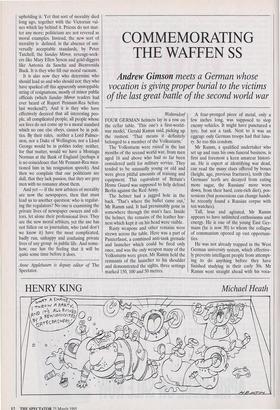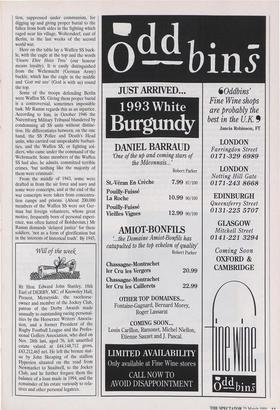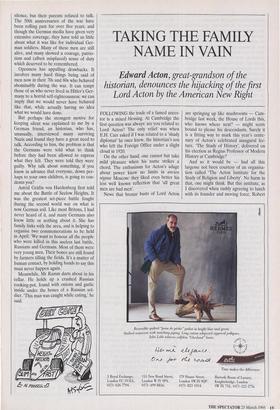COMMEMORATING THE WAFFEN SS
Andrew Gimson meets a German whose
vocation is giving proper burial to the victims of the last great battle of the second world war
Woltersdorf FOUR GERMAN helmets lay in a row on the cellar table. 'This one's a first-world- war model,' Gerald Ramm said, picking up the rustiest. 'That means it definitely belonged to a member of the Volkssturm.' The Volkssturm were raised in the last months of the second world war, from men aged 16 and above who had so far been considered unfit for military service. They tended to be unusually young or old and were given pitiful amounts of training and equipment. This equivalent of Britain's Home Guard was supposed to help defend Berlin against the Red Army. The helmet had a jagged hole in the back. 'That's where the bullet came out,' Mr Ramm said. It had presumably gone in somewhere through the man's face. Inside the helmet, the remains of the leather har- ness which kept it on his head were visible. Rusty weapons and other remains were strewn across the table. Here was a part of Panzerfaust, a combined anti-tank grenade and launcher which could be fired only once, and was the only weapon many of the Volkssturm were given. Mr Ramm held the remnants of the launcher to his shoulder and demonstrated the sights, three settings marked 150, 100 and 50 metres. A four-pronged piece of metal, only a few inches long, was supposed to stop enemy vehicles. It might have punctured a tyre, but not a tank. Next to it was an eggcup: only German troops had that luxu- ry. So too this condom.
Mr Ramm, a qualified undertaker who set up and runs his own funeral business, is first and foremost a keen amateur histori- an. He is expert at identifying war dead, can read the many clues offered by bones (height, age, previous fractures), teeth (the Germans' teeth are decayed from eating more sugar, the Russians' more worn down, from their hard, corn-rich diet), pos- sessions (but possessions can change hands: he recently found a Russian corpse with ten watches).
Tall, lean and agitated, Mr Ramm appears to have unlimited enthusiasms and energy. He is one of the young East Ger- mans (he is now 30) to whom the collapse of communism opened up vast opportuni- ties.
He was not already trapped in the West German university system, which effective- ly prevents intelligent people from attempt- ing to do anything before they have finished studying in their early 30s. Mr Ramm went straight ahead with his voca- tion, suppressed under communism, for digging up and giving proper burial to the fallen from both sides in the fighting which raged near his village, Woltersdorf, east of Berlin, in the last weeks of the second world war.
Here on the table lay a Waffen SS buck- le, with the eagle at the top and the words `Unsere Ehre Heiss Treu' (our honour means loyalty). It is easily distinguished from the Wehrmacht (German Army) buckle, which has the eagle in the middle and 'Gott mit uns' (God is with us) round the top.
Some of the troops defending Berlin were Waffen SS. Giving them proper burial is a controversial, sometimes impossible task. Mr Ramm regards this as an injustice. According to him, in October 1946 the Nuremburg Military Tribunal blundered by condemning all SS units without distinc- tion. He differentiates between, on the one hand, the SS Police and Death's Head units, who carried out unspeakable barbari- ties, and the Waffen SS, or fighting sol- diers, who came under the command of the Wehrmacht. Some members of the Waffen SS had also, he admits, committed terrible crimes, 'but nothing like the majority of them were criminals'.
From the middle of 1943, some were drafted in from the air force and navy and some were conscripts, and at the end of the war conscripts were taken from concentra- tion camps and prisons. (About 200,000 members of the Waffen SS were not Ger- man but foreign volunteers, whose great motive, frequently born of personal experi- ence, was often hatred of Bolshevism.) Mr Ramm demands 'delayed justice' for these soldiers, 'not as a form of glorification but in the interests of historical truth'. By 1945, many of them were fighting not from ideo- logical conviction, but for survival, and many were in any case too newly in uni- form to have committed crimes.
Most Germans would rather not explore these polluted waters. Unpleasant discover- ies await all who do, whatever their ideo- logical position. The indefatigable Mr Ramm publishes books of local history under his own imprint. In his collection of personal accounts called Gott Mit Uns, a former SS man (he was 19 at the time) tells how he was billeted one night in February 1945 in a concentration camp, was horri- fied to discover the bodies of former inmates in a half-filled trench, and was even more shocked when other members of the SS lynched some prisoners they found hiding under a pile of clothes. To admit that such things happened is regard- ed by some of the speaker's former com- rades as tantamount to treachery. They are disgusted with him for letting down the side.
The objects found with a fallen soldier are usually put back with him in his new grave, but Mr Ramm has also established a small collection of local history in the cellar of a villa built in 1930 for the mayor of Woltersdorf. (It was used for most of the post-war period by the Stasi, the East Ger- man secret police.) All the relics there were found in the last two years, in the
course of works on Bundesstrasse 1 Federal Highway 1 — running eastwards from Berlin.
The Russians came this way in April 1945 (when it was still called Reichsstrasse 1 — Imperial Highway 1), driving forward after the Battle of the Seelow Heights, the decisive engagement of 16-19 April 1945 in which they stormed the escarpment west of the River Oder. They had established a bridgehead across the river itself in Jan- uary: the heights were only the last signifi- cant obstacle between themselves and Berlin, only 40 miles away, and were defended tenaciously by about a million Germans, faced by 2.5 million Soviet troops. Perhaps 12,000 Germans and 33,000 Russians were killed.
Many of the fallen never received proper burial. The Russians erected 600 military cemeteries in the lands which became East Germany, but the purpose was propaganda — to remind each town and village who `liberated' it — not the care of individual bodies. The German dead were Collectively dismissed as fascist war criminals, and many lay where they fell, in field graves, perhaps with a helmet on a wooden cross. In the atrocious years of Russian occupa- tion immediately after the war, there was nothing more to be done.
The East German authorities razed many of these makeshift German graves,
and forbade that the dead be spoken of. The heath grew back and silence fell on the German role in the Battle of the Seelow Heights. Schoolchildren were told where Lenin and Marx were buried, not their own fathers and grandfathers. An out-of-date leaflet obtainable (along with post-1989 booklets) at the Seelow Heights museum and memorial, beneath the victory monu- ment erected in autumn 1945 by order of the Soviet commander, Marshal Zhukov, describes it as 'a place of proletarian inter- nationalism and socialist patriotism'. This idea left not only no place for German patriotism, but none for the proper mourn- ing of sons, brothers, husbands, fathers.
Mr Ramm has been accused by some of his neighbours of promoting fascism by printing fascist stories. But the great value of what he does — and of the work of insti- tutions like the Deutsche Dienstelle (which traces the surviving family of the dead sol- dier), and the Volksbund Deutsche Kriegs- graberfiirsorge (which looks after war graves) — is that it takes the history of the war away from endless moralising, down to , the experience of the individual German soldier.
There is unlimited public breast-beating in Germany about the horrors of Auschwitz etc., and tacit agreement not to ask what particular Germans did. The stu- dent rebels of 1968 tried to break this silence, but their parents refused to talk. The 50th anniversaries of the war have been rolling past for over five years, and though the German media have given very extensive coverage, they have told us little about what it was like for individual Ger- man soldiers. Many of these men are still alive, and many showed a courage, patrio- tism and (albeit misplaced) sense of duty which deserved to be remembered.
Openness has appalling drawbacks. It involves many hard things being said of men now in their 70s and 80s who behaved abominably during the war. It can tempt those of us who never lived in Hitler's Ger- many to a horrid self-righteousness: we can imply that we would never have behaved like that, while actually having no idea what we would have done.
But perhaps the strongest motive for keeping silent was explained to me by a German friend, an historian, who has, unusually, interviewed many surviving Nazis and found they have a great need to talk. According to him, the problem is that the Germans were told what to think before they had been allowed to express what they felt. They were told they were guilty. Why talk about something, if you know in advance that everyone, down per- haps to your own children, is going to con- demn you?
Astrid Grafin von Hardenberg first told me about the Battle of Seelow Heights. It was the greatest set-piece battle fought during the second world war on what is now German soil. Like most Britons, I had never heard of it, and many Germans also know little or nothing about it. She has family links with the area, and is helping to organise two commemorations to be held in April: 'We want to honour all the people who were killed in this useless last battle, Russians and Germans. Most of them were very young men. Their bones are still found by farmers tilling the fields. It's a matter of human contact, by holding hands to say this must never happen again.'
Meanwhile, Mr Ramm darts about in his cellar. He holds up a crushed Russian cooking-pot, found with onions and garlic inside under the bones of a Russian sol- dier. 'This man was caught while eating,' he said.





























































 Previous page
Previous page